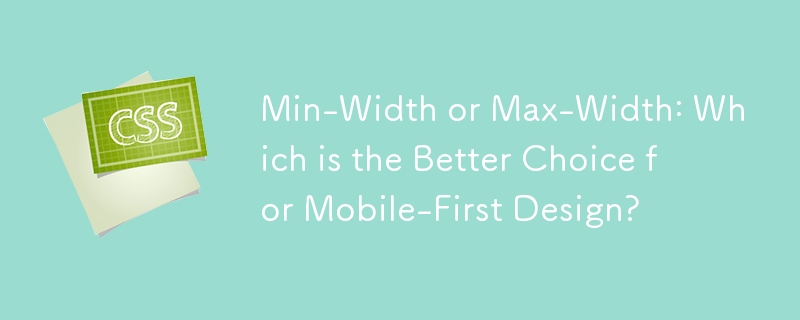最小寬度或最大寬度:哪個是行動優先設計的更好選擇?
- Patricia Arquette原創
- 2024-11-03 04:28:03393瀏覽

最大寬度與最小寬度:移動優先的視角
當涉及使用媒體查詢時,最小寬度之間的選擇-width和max-width 常出現。雖然 min-width 在行動優先設計中更為普遍,但了解這兩種方法背後的基本原理至關重要。
移動優先設計和min-width
原理移動優先設計的背後是從為移動設備量身定制的樣式開始,並逐步增強針對更大屏幕的佈局。 min-width 媒體查詢遵循此流程。
使用 min-width,預設樣式適用於行動裝置。後續查詢逐漸針對更寬的螢幕:
<code class="css">body {
/* Default mobile styles */
}
@media screen and (min-width: 480px) {
/* Styles for screens 480px and wider */
}
@media screen and (min-width: 800px) {
/* Styles for screens 800px and wider */
}</code>
桌面優先設計和最大寬度
相反,桌面優先設計從桌面和使用的樣式開始max- width 查詢以適應較小的螢幕:
<code class="css">body {
/* Default desktop styles */
}
@media screen and (max-width: 800px) {
/* Styles for screens 800px and narrower */
}
@media screen and (max-width: 480px) {
/* Styles for screens 480px and narrower */
}</code>
自訂導覽為360 像素或更小
對於寬度為360 像素或更小的自訂導航定位設備,如果它是行動優先設計的孤立例外,則可以使用max-width:
<code class="css">body {
/* Default mobile styles (also applies to 361-479px) */
}
@media screen and (max-width: 360px) {
/* Custom styles for screens 360px and narrower */
}
@media screen and (min-width: 480px) {
/* Styles for screens 480px and wider */
}</code>
但是,通常建議優先考慮行動優先原則並使用min-width 進行漸進增強,方法是:包括360px 異常作為輔助查詢,或將其樣式設為基線並覆蓋它以獲得更寬的螢幕。
以上是最小寬度或最大寬度:哪個是行動優先設計的更好選擇?的詳細內容。更多資訊請關注PHP中文網其他相關文章!
陳述:
本文內容由網友自願投稿,版權歸原作者所有。本站不承擔相應的法律責任。如發現涉嫌抄襲或侵權的內容,請聯絡admin@php.cn

